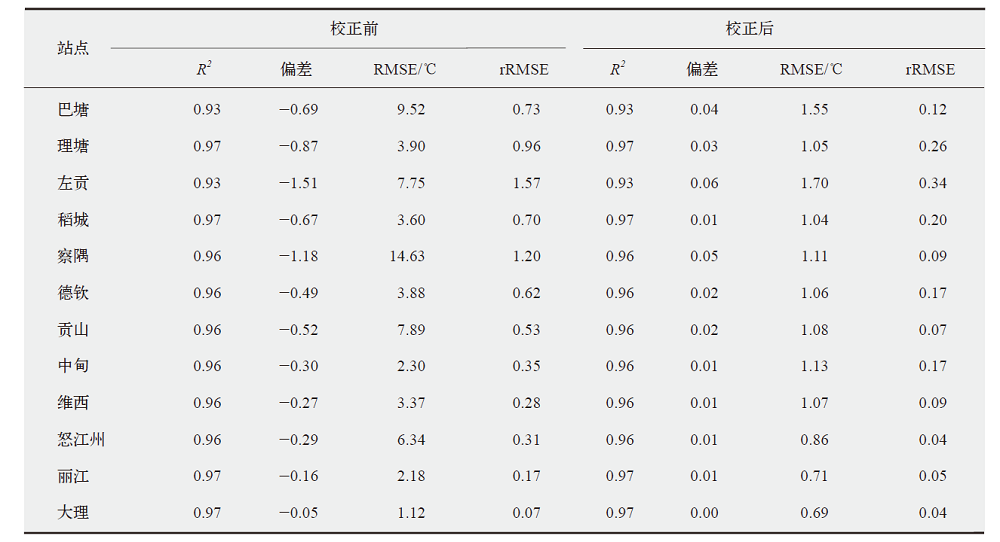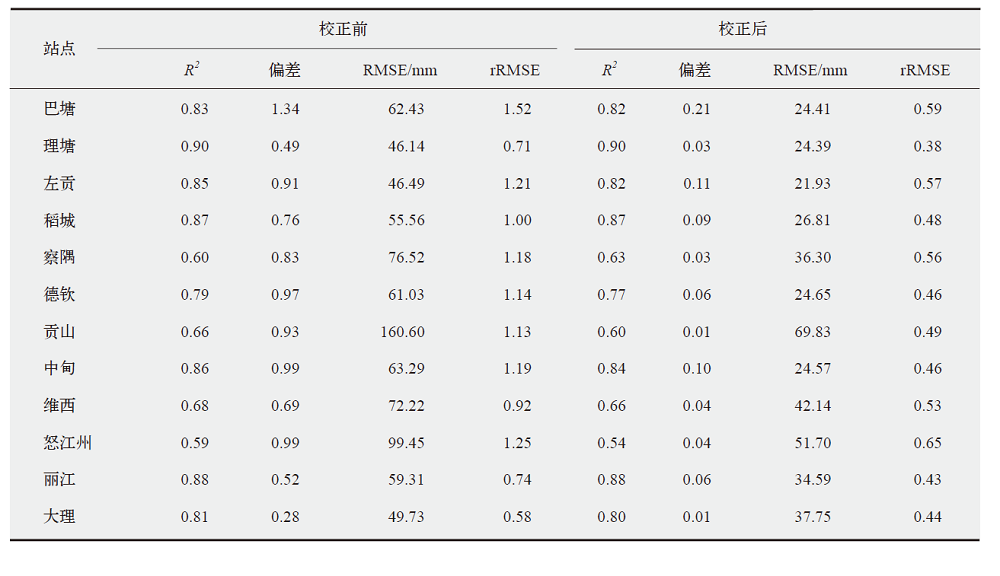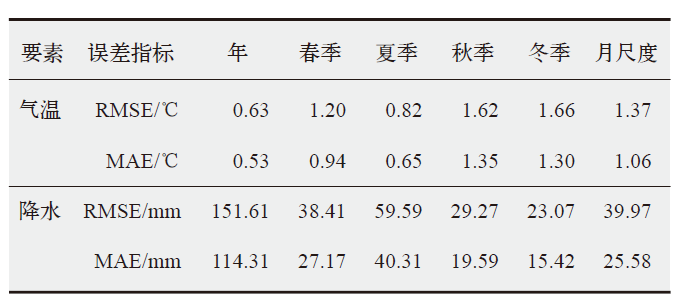Climate Change Research ›› 2022, Vol. 18 ›› Issue (3): 328-342.doi: 10.12006/j.issn.1673-1719.2021.207
• Changes in Climate System • Previous Articles Next Articles
Spatio-temporal differentiation and altitude dependence of temperature and precipitation in Meili Snow Mountains
MIAO Wen-Fei( ), LIU Shi-Yin(
), LIU Shi-Yin( ), ZHU Yu, DUAN Shi-Mei, HAN Feng-Ze
), ZHU Yu, DUAN Shi-Mei, HAN Feng-Ze
- Institute of International Rivers and Eco-Security, Yunnan University, Kunming 650500, China
-
Received:2021-09-13Revised:2021-11-09Online:2022-05-30Published:2022-02-25 -
Contact:LIU Shi-Yin E-mail:wenfei.miao@mail.ynu.edu.cn;shiyin.liu@ynu.edu.cn
Cite this article
MIAO Wen-Fei, LIU Shi-Yin, ZHU Yu, DUAN Shi-Mei, HAN Feng-Ze. Spatio-temporal differentiation and altitude dependence of temperature and precipitation in Meili Snow Mountains[J]. Climate Change Research, 2022, 18(3): 328-342.
share this article
Add to citation manager EndNote|Ris|BibTeX
URL: http://www.climatechange.cn/EN/10.12006/j.issn.1673-1719.2021.207

Fig. 1 Geographical settings of study area. (a) Weather stations and Thiessen polygon around the study area, (b) Meili Snow Mountains Region (MLSM), (c) location of rain gauge and relationship between precipitation and altitude in Mingyong Glacier basin

Fig. 2 The component characteristics of ERA5-Land grid before and after precipitation correction at Deqin station. (a) Trend items, (b) seasonal items, (c) residual items

Fig. 3 Spatial distribution of trends of seasonal and annual air temperature in MLSM during 1990-2020 spring (a), summer (b), autumn (c), winter (d), annual average (e), and variation of regional annual average air temperature (f)

Fig. 7 Atmospheric circulation changes during 1990-2020. (a) 500 hPa heights during monsoon period, (b) 500 hPa specific humidity, (c) 850 hPa temperature, (d) 200 hPa westward wind
| [1] | 李庆, 张春来, 王仁德, 等. 1965-2016年青藏高原关键气象因子变化特征及其对土地沙漠化的影响[J]. 北京师范大学学报: 自然科学版, 2018, 54 (5): 659-665. |
| Li Q, Zhang C L, Wang R D, et al. Climate change and impact on desertification in Qinhai-Tibet Plateau from 1965-2016[J]. Journal of Beijing Normal University: Natural Science, 2018, 54 (5): 659-665 (in Chinese) | |
| [2] | 李宗省, 何元庆, 辛惠娟, 等. 我国横断山区1960-2008年气温和降水时空变化特征[J]. 地理学报, 2010, 65 (5): 563-579. |
| Li Z X, He Y Q, Xin H J, et al. Spatio-temporal variations of temperature and precipitation in Mts. Hengduan region during 1960-2008[J]. Acta Geographica Sinica, 2010, 65 (5): 563-579 (in Chinese) | |
| [3] | 丁文荣. 横断山区干旱河谷气候变化趋势研究[J]. 生态与农村环境学报, 2013, 29 (6): 681-687. |
| Ding W R. Trend of the climate changes in dry valleys of Hengduan Mountains, China[J]. Journal of Ecology and Rural Environment, 2013, 29 (6): 681-687 (in Chinese) | |
| [4] | 徐飞, 贾仰文, 牛存稳, 等. 横断山区气温和降水年季月变化特征[J]. 山地学报, 2018, 36 (2): 171-183. |
| Xu F, Jia Y W, Niu C W, et al. Variation character of annual, seasonal and monthly temperature and precipitation[J]. Mountain Research, 2018, 36 (2): 171-183 (in Chinese) | |
| [5] | 张涛, 李宝林, 何元庆, 等. 基于TRMM订正数据的横断山区降水时空分布特征[J]. 自然资源学报, 2015 (2): 260-270. |
| Zhang T, Li B L, He Y Q, et al. Spatial and temporal distribution of precipitation based on corrected TRMM data in Hengduan Mountains[J]. Journal of Natural Resources, 2015 (2): 260-270 (in Chinese) | |
| [6] |
Guo D L, Yu E T, Wang H. Will the Tibetan Plateau warming depend on elevation in the future?[J]. Journal of Geophysical Research: Atmospheres, 2016, 121 (8): 3969-3978
doi: 10.1002/2016JD024871 URL |
| [7] |
Gao Y H, Chen F, Lettenmaier D P, et al. Does elevation-dependent warming hold true above 5000 m elevation? Lessons from the Tibetan Plateau[J]. NPJ Climate and Atmospheric Science, 2018, 1 (1): 1-7
doi: 10.1038/s41612-017-0007-3 URL |
| [8] |
Guo D L, Sun J Q, Yang K, et al. Revisiting recent elevation‐dependent warming on the Tibetan Plateau using satellite based data sets[J]. Journal of Geophysical Research: Atmospheres, 2019, 124 (15): 8511-8521
doi: 10.1029/2019JD030666 URL |
| [9] |
Qin J, Yang K, Liang S L, et al. The altitudinal dependence of recent rapid warming over the Tibetan Plateau[J]. Climatic Change, 2009, 97 (1): 321-327
doi: 10.1007/s10584-009-9733-9 URL |
| [10] | 王朋岭, 唐国利, 曹丽娟, 等. 1981-2010年青藏高原地区气温变化与高程及纬度的关系[J]. 气候变化研究进展, 2012, 8 (5): 313-319. |
| Wang P L, Tang G L, Cao L J, et al. Surface air temperature variability and its relationship with altitude & latitude over the Tibetan Plateau in 1981-2010[J]. Climate Change Research, 2012, 8 (5): 313-319 (in Chinese) | |
| [11] | 孙赫, 苏凤阁, 黄敬恒, 等. 第三极西风和季风主导流域源区降水呈现不同梯度特征[J]. 科学通报, 2020, 65 (1): 97-110. |
| Sun H, Su F G, Huang J H, et al. Contrasting precipitation gradient characteristics between westerlies and monsoon dominated upstream river basins in the Third Pole[J]. Chinese Science Bulletin, 2020, 65 (1): 97-110 (in Chinese) | |
| [12] |
Immerzeel W W, Pellicciotti F, Shrestha A B. Glaciers as a proxy to quantify the spatial distribution of precipitation in the Hunza basin[J]. Mountain Research and Development, 2012, 32 (1): 30-38
doi: 10.1659/MRD-JOURNAL-D-11-00097.1 URL |
| [13] |
Zhou X, Yang K, Ouyang L, et al. Added value of kilometer-scale modeling over the Third Pole region: a CORDEX-CPTP pilot study[J]. Climate Dynamics, 2021, 57 (7): 1673-1687
doi: 10.1007/s00382-021-05653-8 URL |
| [14] | Jiang Y Z, Yang K, Shao C K, et al. A downscaling approach for constructing high-resolution precipitation dataset over the Tibetan Plateau from ERA5 reanalysis[J]. Atmospheric Research, 2021, 256: 105574 |
| [15] |
Ma J Y, Dong W J, Wei Z G, et al. Evaluating daily surface maximum temperature interpolation error by adding climate stations near border areas over China[J]. International Journal of Climatology, 2015, 35 (10): 2798-2808
doi: 10.1002/joc.4173 URL |
| [16] |
Rigden A J, Salvucci G D. Evapotranspiration based on equilibrated relative humidity (ETRHEQ): evaluation over the continental US[J]. Water Resources Research, 2015, 51 (4): 2951-2973
doi: 10.1002/2014WR016072 URL |
| [17] |
Persaud B D, Whitfield P H, Quinton W L, et al. Evaluating the suitability of three gridded datasets and their impacts on hydrological simulation at Scotty Creek in the southern Northwest Territories, Canada[J]. Hydrological Processes, 2020, 34 (4): 898-913
doi: 10.1002/hyp.13663 URL |
| [18] | Wen H Y, Che F J, Li J, et al. A study on spatial interpolation of temperature in Anhui province based on ANUSPLIN[J]. Meteorological and Environmental Research, 2019, 10 (2): 51-60 |
| [19] | 刘志红, 杨勤科, 李锐, 等. 基于ANUSPLIN的时间序列气象要素空间插值[J]. 西北农林科技大学学报: 自然科学版, 2008, 36 (10): 227-234. |
| Liu Z H, Yang Q K, Li R, et al. Interpolation for time series of meteorological variables using ANUSPLIN[J]. Journal of Northwest A & F University: Natural Science Edition, 2008, 36 (10): 227-234 (in Chinese) | |
| [20] |
贾洋, 崔鹏. 高山区多时间尺度Anusplin气温插值精度对比分析[J]. 高原气象, 2018, 37 (3): 757-766.
doi: 10.7522/j.issn.1000-0534.2017.00072 |
| Jia Y, Cui P. Contrastive analysis of temperature interpolation at different time scales in the Alpine Region by Anusplin[J]. Plateau Meteorology, 2018, 37 (3): 757-766 (in Chinese) | |
| [21] |
谭剑波, 李爱农, 雷光斌. 青藏高原东南缘气象要素Anusplin和Cokriging空间插值对比分析[J]. 高原气象, 2016, 35 (4): 875-886.
doi: 10.7522/j.issn.1000-0534.2015.00037 |
| Tan J B, Li A N, Lei G B. Contrast on Anusplin and Cokriging meteorological spatial interpolation in Southeastern margin of Qinghai-Xizang Plateau[J]. Plateau Meteorology, 2016, 35 (4): 875-886 (in Chinese) | |
| [22] | 乔云亭, 陈烈庭, 张庆云. 东亚季风指数的定义及其与中国气候的关系[J]. 大气科学, 2002 (1): 69-82. |
| Qiao Y T, Chen L T, Zhang Q Y. The definition of East Asian monsoon Indices and their relationship to climate in China[J]. Chinese Journal of Atmospheric Sciences, 2002 (1): 69-82 (in Chinese) | |
| [23] |
Yu W S, Wei F L, Ma Y M, et al. Stable isotope variations in precipitation over Deqin on the southeastern margin of the Tibetan Plateau during different seasons related to various meteorological factors and moisture sources[J]. Atmospheric Research, 2016, 170: 123-130
doi: 10.1016/j.atmosres.2015.11.013 URL |
| [24] | 张志明, 王文礼, 欧晓昆, 等. 梅里雪山植被空间格局与环境因子关系分析[J]. 云南大学学报: 自然科学版, 2009, 31 (3): 311-315. |
| Zhang Z M, Wang W L, Ou X K, et al. The correlation between vegetation spatial pattern and environmental factors[J]. Journal of Yunnan University: Natural Sciences Edition, 2009, 31 (3): 311-315 | |
| [25] | 施雅风, 刘时银. 中国冰川对21世纪全球变暖响应的预估[J]. 科学通报, 2000, 45 (4): 434-438. |
| Shi Y F, Liu S Y. Prediction of the response of Chinese glaciers to global warming in the 21st century[J]. Chinese Science Bulletin, 2000, 45 (4): 434-438 (in Chinese) | |
| [26] | 何大明, 吴绍洪, 彭华, 等. 纵向岭谷区生态系统变化及西南跨境生态安全研究[J]. 地球科学进展, 2005, 20 (3): 338-344. |
| He D M, Wu S H, Peng H, et al. A study of ecosystem changes in longitudinal range-gorge region and transboundary eco-security in Southwest China[J]. Advances in Earth Science, 2005, 20 (3): 338-344 (in Chinese) | |
| [27] |
阳坤, 何杰. 中国区域地面气象要素驱动数据集(1979-2018)[DB]. 国家青藏高原科学数据中心, 2019. DOI: 10.11888/AtmosphericPhysics.tpe.249369.file.
doi: 10.11888/AtmosphericPhysics.tpe.249369.file |
|
Yang K, He J. China meteorological forcing dataset (1979-2018)[DB]. National Tibetan Plateau Data Center, 2019. DOI: 10.11888/AtmosphericPhysics.tpe.249369.file (in Chinese)
doi: 10.11888/AtmosphericPhysics.tpe.249369.file |
|
| [28] |
许尔琪. 青藏高原土地利用数据(1992、2005和2015)(V1.0)[DB]. 国家青藏高原科学数据中心, 2019. DOI: 10.11888/Geogra.tpdc.270198.
doi: 10.11888/Geogra.tpdc.270198 |
|
Xu E Q. Land use of the Tibet Plateau in 2015 (Version 1.0)[DB]. National Tibetan Plateau Data Center, 2019. DOI: 10.11888/Geogra.tpdc.270198 (in Chinese)
doi: 10.11888/Geogra.tpdc.270198 |
|
| [29] | AghaKouchak A, Mehran A, Norouzi H, et al. Systematic and random error components in satellite precipitation data sets[J]. Geophysical Research Letters, 2012, 39 (9): 9406-9409 |
| [30] | 尹家波, 郭生练, 王俊, 等. 基于贝叶斯模式平均方法融合多源数据的水文模拟研究[J]. 水利学报, 2020, 51 (11): 1335-1346. |
| Yin J B, Guo S L, Wang J, et al. Blending multi-source data in hydrological simulations based on BMA method[J]. Journal of Hydraulic Engineering, 2020, 51 (11): 1335-1346 (in Chinese) | |
| [31] | Yi Y, Liu S Y, Zhu Y, et al. Spatiotemporal heterogeneity of snow cover in the central and western Karakoram Mountains based on a refined MODIS product during 2002-2018[J]. Atmospheric Research, 2021, 250: 105402 |
| [32] |
Zhu Y, Liu S Y, Yi Y, et al. Spatio-temporal variations in terrestrial water storage and its controlling factors in the Eastern Qinghai-Tibet Plateau[J]. Hydrology Research, 2021, 52 (1): 323-338
doi: 10.2166/nh.2020.039 URL |
| [33] | Robert C, William C, Irma T. STL: a seasonal-trend decomposition procedure based on loess[J]. Journal of Official Statistics, 1990, 6 (1): 3-73 |
| [34] | Hutchinson M F. Anusplin version 4.2 user guide[M]. Canberra: Australian National University, 2001 |
| [35] |
陆福志, 鹿化煜. 秦岭-大巴山高分辨率气温和降水格点数据集的建立及其对区域气候的指示[J]. 地理学报, 2019, 74 (5): 875-888.
doi: 10.11821/dlxb201905003 |
| Lu F Z, Lu H Y. A high-resolution grid dataset of air temperature and precipitation for Qinling-Daba Mountains in central China and its implications for regional climate[J]. Acta Geographica Sinica, 2019, 74 (5): 875-888 (in Chinese) | |
| [36] |
Du Q Q, Zhang M J, Wang S J, et al. Changes in air temperature over China in response to the recent global warming hiatus[J]. Journal of Geographical Sciences, 2019, 29 (4): 496-516
doi: 10.1007/s11442-019-1612-3 URL |
| [37] | Winslow L A, Leach T H, Rose K C. Global lake response to the recent warming hiatus[J]. Environmental Research Letters, 2018, 13 (5): 054005 |
| [38] | IPCC. Climate change 2013: the physical science basis[M]. Cambridge: Cambridge University Press, 2013 |
| [39] |
Dimri A P, Niyogi D, Barros A P, et al. Western disturbances: a review[J]. Reviews of Geophysics, 2015, 53 (2): 225-246
doi: 10.1002/2014RG000460 URL |
| [40] | Sun H, Su F G, Huang J H, et al. Contrasting precipitation gradient characteristics between westerlies and monsoon dominated upstream river basins in the Third Pole[J]. Chinese Science Bulletin, 2019, 65 (1): 91-104 |
| [41] |
Pepin N, Bradley R S, Diaz H F, et al. Elevation-dependent warming in mountain regions of the world[J]. Nature Climate Change, 2015, 5 (5): 424-430
doi: 10.1038/nclimate2563 URL |
| [42] |
Liu X D, Cheng Z G, Yan L B, et al. Elevation dependency of recent and future minimum surface air temperature trends in the Tibetan Plateau and its surroundings[J]. Global and Planetary Change, 2009, 68: 164-174
doi: 10.1016/j.gloplacha.2009.03.017 URL |
| [43] |
Gao J, Williams M W, Fu X D, et al. Spatiotemporal distribution of snow in eastern Tibet and the response to climate change[J]. Remote Sensing of Environment, 2012, 121: 1-9
doi: 10.1016/j.rse.2012.01.006 URL |
| [44] |
刘时银, 姚晓军, 郭万钦, 等. 基于第二次冰川编目的中国冰川现状[J]. 地理学报, 2015, 70 (1): 3-16.
doi: 10.11821/dlxb201501001 |
| Liu S Y, Yao X J, Guo W Q, et al. The contemporary glaciers in China based on the Second Chinese Glacier inventory[J]. Acta Geographica Sinica, 2015, 70 (1): 3-16 (in Chinese) | |
| [45] |
Hulme M, Osborn T J, Johns T C. Precipitation sensitivity to global warming: comparison of observations with HadCM2 simulations[J]. Geophysical Research Letters, 1998, 25 (17): 3379-3382
doi: 10.1029/98GL02562 URL |
| [1] | LUAN Lan, ZHAI Pan-Mao. Changes in rainy season precipitation properties over the Qinghai-Tibet Plateau based on multi-source datasets [J]. Climate Change Research, 2023, 19(2): 173-190. |
| [2] | TU Kai, YAN Zhong-Wei, FAN Li-Jun, LI Zhen. Study of evaluation method on the climate of extreme high temperatures based on dynamic return periods [J]. Climate Change Research, 2023, 19(1): 11-22. |
| [3] | QIN Zheng, ZHAO Jing-Feng, CHENG Wu-Xue, WANG Jie, SU Hua-Li, HE Ya-Ling. Change of subtropical northern boundary in Qinling−Huaihe region in the context of climate change [J]. Climate Change Research, 2023, 19(1): 38-48. |
| [4] | ZHAN Yun-Jian, CHEN Dong-Hui, LIAO Jie, JU Xiao-Hui, ZHAO Yu-Fei, REN Guo-Yu. Construction of a daily precipitation dataset of 60 city stations in China for the period 1901-2019 [J]. Climate Change Research, 2022, 18(6): 670-682. |
| [5] | ZHANG Shi-Yan, HU Yong-Yun, LI Zhi-Bo. Recent changes and future projection of precipitation in Northwest China [J]. Climate Change Research, 2022, 18(6): 683-694. |
| [6] | LI Tao, TAO Hui, CHEN Jin-Yu. Risk assessment of extreme low temperature events over the China-Pakistan Economic Corridor [J]. Climate Change Research, 2022, 18(3): 343-354. |
| [7] | WANG Xia, WANG Ying, LIN Qi-Gen, LI Ning, ZHANG Xin-Ren, ZHOU Xiao-Ying. Projection of China landslide disasters population risk under climate change [J]. Climate Change Research, 2022, 18(2): 166-176. |
| [8] | ZHANG Xin-Ran, CHEN Hao-Ming. Assessment of warm season precipitation in the eastern slope of the Tibetan Plateau by CMIP6 models [J]. Climate Change Research, 2022, 18(2): 129-141. |
| [9] | LI Ying, ZHAO Shan-Shan. Floods losses and hazards in China from 2001 to 2020 [J]. Climate Change Research, 2022, 18(2): 154-165. |
| [10] | WANG Qian-Zhi, LIU Kai, WANG Ming. Evaluation of extreme precipitation indices performance based on NEX-GDDP downscaling data over China [J]. Climate Change Research, 2022, 18(1): 31-43. |
| [11] | SUN Chen, WANG Fang, ZHOU Yue-Hua, LI Lan. An assessment on extreme precipitation events in Yangtze River basin as simulated by CWRF regional climate model [J]. Climate Change Research, 2022, 18(1): 44-57. |
| [12] | ZHOU Tian-Jun, CHEN Zi-Ming, CHEN Xiao-Long, ZUO Meng, JIANG Jie, HU Shuai. Interpreting IPCC AR6: future global climate based on projection under scenarios and on near-term information [J]. Climate Change Research, 2021, 17(6): 652-663. |
| [13] | HU Yi-Yang, XU Ying, LI Jin-Jian, HAN Zhen-Yu. Evaluation on the performance of CMIP6 global climate models with different horizontal resolution in simulating the precipitation over China [J]. Climate Change Research, 2021, 17(6): 730-743. |
| [14] | HE Jia-Jun, REN Guo-Yu, ZHANG Pan-Feng. Effects of data homogenization on the estimates of temperature trend and urbanization bias: taking Beijing area as an example [J]. Climate Change Research, 2021, 17(5): 503-513. |
| [15] | CHEN Yan, HUI Pin-Hong, ZHOU Xue-Dong, YANG Jie. Influence of climate change on the volume capture ratio of annual rainfall’s partition [J]. Climate Change Research, 2021, 17(5): 525-536. |
| Viewed | ||||||
|
Full text |
|
|||||
|
Abstract |
|
|||||








